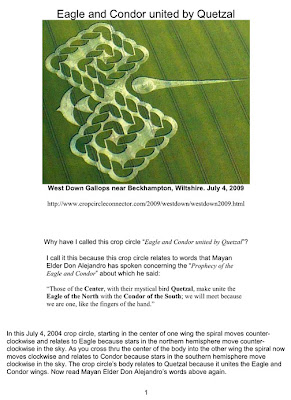Crop Circle 4th July 
Click On These To Enlarge 

Each wing of this July 4th crop circle has 21 parts forming it's spiral so the Eagle and Condor spirals united is 21 + 21 = 42. The number 42 relates to the Sixth Sun Tzolkin because that Tzolkin has exactly 42 symbols that form all of it's day signs.
Crop Circle Silbury , Wiltshire, 5th July (Quetzalcoatl Headdress) 
The Mayan Calendar was allegedly created by Quetzalcoatl.
As the Lord of the East he is associated with the morning star, (Satan is the morning star) his twin brother Xolotl was the evening star (Venus). As the morning star he was known by the name Tlahuizcalpantecuhtli, "lord of the star of the dawn." An other representation of Quetzalcoatl is Ehecatl, the Wind God. His calendrical name is Ce Acatl (One Reed).
After the last world, the Fourth Sun had been destroyed, Quetzalcoatl went to Mictlan, the land of the death, and created our current world, the Fifth Sun, by using his own blood to give new life to bones. Quetzalcoatl is also the giver of maize (CORN) to mankind.
Quetzalcoatl - This Aztec god controlled the sun and all its mighty powers. 



Quetzalcoatl 
Natives of Mexico insisted that the great god Quetzalcoatl, a sun god who ruled before the present sun, was their first king and founder of the kingship rites. He not only introduced all of the arts of civilization, but presided over an ancient paradise.
The ancient Maya proclaimed that their once-spectacular civilization had its origins in the rule of the creator-king and god of the Golden Age, Itzam Na. At the center of Mayan culture, stood the sovereign chief, announcing himself as something like "the King of Kings and ruler of the world, regent on earth of the great Itzam Na."
Natives of Mexico recall that prior to the present age, an exemplary sun ruled the world, but this was not the sun of today. His name was Quetzalcoatl. The Maya maintained essentially the same idea, calling the primeval sun god Huracan. The Incas of Peru spoke of a former sun superior to the present sun. To the ancient Egyptians, the sun god Atum-Ra, the model ruler, reigned over the fortunate era for a time, then retired from the world. The Sumerian An, ruling with "terrifying splendor," was the dominating luminary of the sky, but not our sun. Later the god departed to a more remote domain.
When it comes to the well-known sun gods of early man, nothing in the mytho-astronomical record seems to have unnerved the experts. Nor should is surprise us that scholars today have no doubt that the Greek Helios, Latin Sol, Assyrian Shamash, or Egyptian Ra, were the Sun pure and simple. In Egypt, countless hymns to the god Ra extol him as the divine power opening the "day." "The lords of all lands. . . praise Ra when he riseth at the beginning of each day." Ra is the "great Light who shinest in the heavens. . . Thou art glorious by reason of thy splendors. . ."
In the same way, Assyrian and Babylonian texts depict the god Shamash as the supreme light of the sky. Such images would seem to leave no question as to the solar character of these gods.
Yet a dilemma arise. During the past century several authorities noticed that Greek and Latin astronomical texts show a mysterious confusion of the "Sun"--Greek Helios, Latin Sol--with the outermost planet, Saturn. Though the designation seems bizarre, the expression "star of Helios" or "star of Sol" was applied to Saturn! Of the Babylonian star-worshippers the chronicler Diodorus writes: "To the one we call Saturn they give a special name, 'Sun-Star.'"
Similarly, the Greek historian Nonnus gives Kronos as the Arab name of the "sun," though Kronos meant only Saturn and no other celestial body. Hyginus, in listing the planets, names first Jupiter, then the planet "of Sol, others say of Saturn." A Greek ostrakon, cited by the eminent classicist Franz Boll, identifies the Egyptian sun god Ra, not with our sun, but with the planet Saturn. This repeated confusion of the Sun and Saturn seems to make no sense at all. Can you imagine any difficulty in separating the two bodies, or distinguishing the one from the other?
One fact beyond dispute is that the word Helios did become the Greek word for our Sun, just as the Latin Sol gave his name to our Sun. The same can be said for the older Shamash and Ra: the names of these gods became the names for the solar orb. But that's where the connection with our Sun ends and the mystery of Saturn, the Universal Monarch, begins.
Saturnalia Golden Age
Saturnalia, which honored Saturn, was one of early Rome's most important festivals. The Roman poet Ovid said Saturn was king of a "Golden Age" in the time of Arcadians who lived on Earth before Jupiter was born, and are of a race that "predates the moon." Ovid also wrote of that time:
"The earth gave forth all good things of her own accord, and mankind, content with foods created without labor, picked the fruit of the trees and the mountain strawberries and the cornel cherries and the mulberries clinging to the wild thickets and acorns that fell from the spreading oak of Jupiter.
"Spring was eternal, and the gentle breezes caressed the flowers, all springing forth without seed, with clear warm air. Soon, also, the unplowed earth was rich with grain, and fields always fertile, were white with the heavy beards of corn. Then rivers of milk, then streams of nectar flowed forth..."
Ancient Egyptians frequently referred to a Golden Age by the name of Zep Tepi, 'The First Time' of Osiris (the constellation known to us as Orion). They believed Zep Tepi had long predated the Pyramid Age. Egyptians also referred to it as the "Age of Ra."
Romans and Egyptians were not the only peoples who had a memory of a Golden Age. Greek tradition also recalls the prosperous epoch of the god Kronos (Saturn); they believed it was a time when the whole world enjoyed peace and plenty. Chinese referred to it as the Age of "Perfect Virtue." Hindus had a Golden Age called "Satya yuga" or perfect age.
Generally, the Golden Age was thought of as a timeless epoch before the arrival of discord and war, and before a "linkage" of heaven with Earth was broken. Most of those early cultures also connected the Golden Age with the rule of a Universal Monarch: the Akkadian Anu, the Sumerian An, the Hindu Yama, the Persian Yima, the Norse Frodhi, the Chinese Huang-ti and the Mexican Quetzalcoatl. All of these are claimed to be founding kings, often as the first in what those peoples believed was an unbroken line of rulers.
Monday, 6 July 2009
UK “Quetzalcoatl Headdress” Crop Circle 5th July.
Posted by
Choosing Freedom
at
02:16
![]()
Labels: Crop Circle, Golden age, Headdress, July 5, Mayans, Osiris, Quetzalcoatl, Ra, Saturn, Saturnalian
Subscribe to:
Post Comments (Atom)












No comments:
Post a Comment
No Censorship here, just keep it clean please! thank you.